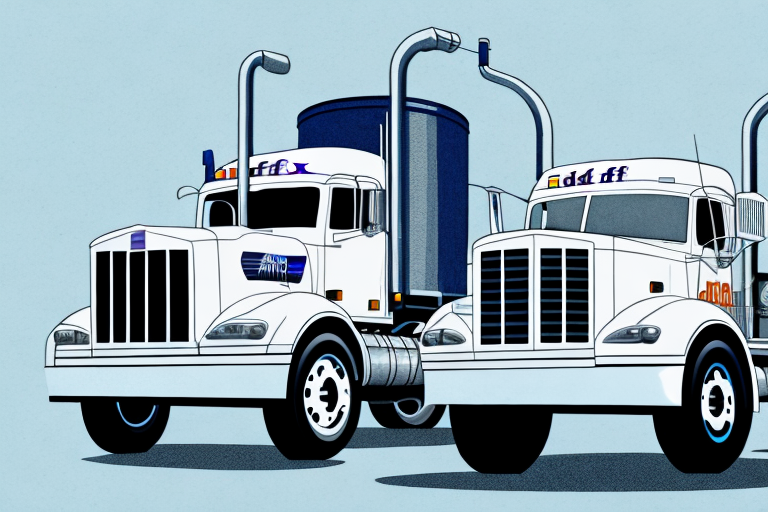Calculating the Total Cost to Deliver Your Goods
If you're a business owner involved in delivering goods, accurately calculating the total cost of delivery is essential for determining your business's profitability. Delivery costs can accumulate rapidly, significantly impacting your margins. Establishing a precise calculation process is critical to maintaining healthy profits. This comprehensive guide will walk you through the factors and strategies involved in calculating the total cost of delivery.
Factors Affecting the Total Cost of Delivery
The total cost of delivery is influenced by multiple factors, including:
- Distance: Longer delivery routes typically incur higher costs due to increased fuel consumption and labor hours.
- Weight and Dimensions: Heavier and larger shipments cost more to transport.
- Type of Shipment: Perishable or fragile items may require specialized handling, increasing costs.
- Mode of Transportation: Air freight is generally more expensive than sea or ground transport.
- Delivery Speed: Expedited shipping options cost more than standard delivery.
- Insurance: Protecting your goods against loss or damage adds to the total cost.
- Packaging: Quality packaging materials can enhance protection but may increase expenses.
Additionally, customs regulations in the destination country can impact costs. Some countries impose strict regulations and additional fees on certain products, potentially causing delays and unexpected expenses. Researching and understanding these regulations before shipping internationally is crucial to avoid unforeseen costs.
According to a Investopedia report, shipping and handling costs account for approximately 10-15% of a company's total expenses, highlighting the importance of accurate cost calculation.
Importance of Accurate Cost Calculation in Delivery
Accurate cost calculation plays a pivotal role in delivery operations by:
- Establishing Competitive Pricing: Understanding delivery costs allows you to set prices that ensure profitability while remaining competitive.
- Managing Cash Flow: Precise cost estimates help in forecasting expenses and managing the business's financial health.
- Identifying Profitable Products: Determine which products offer the best margins by analyzing delivery costs.
- Reducing Unnecessary Expenses: Spot inefficiencies in the delivery process to streamline operations and cut costs.
Implementing accurate cost calculations enables businesses to make informed decisions, optimize their delivery strategies, and enhance overall profitability.
Understanding Shipping and Handling Fees
Shipping and handling fees encompass various charges associated with delivering goods to their destination. These fees typically include:
- Transportation Costs: Expenses related to the movement of goods via air, sea, or land.
- Handling Fees: Costs for loading, unloading, and managing shipments.
- Packaging Costs: Expenses for materials used to secure goods during transit.
It's crucial to incorporate these fees into your total cost calculations to avoid underestimating delivery expenses. Shipping and handling fees can vary significantly based on the carrier and the specific services required.
Different shipping methods offer varying costs and delivery times:
- Standard Shipping: More affordable but slower, suitable for non-urgent deliveries.
- Expedited Shipping: Higher cost for faster delivery times, ideal for time-sensitive shipments.
Additionally, factors such as package weight, size, and the nature of the goods (e.g., fragile or hazardous materials) can influence shipping and handling costs. Understanding these variables allows for more accurate budgeting and cost management.
How to Calculate Shipping Costs for Your Business
Calculating shipping costs involves several steps:
- Determine the distance between the origin and destination.
- Assess the weight and dimensions of the shipment.
- Identify the type of shipment (e.g., perishable, fragile).
- Choose the mode of transportation (air, sea, land).
Most carriers offer shipping calculators to estimate costs. However, understanding the underlying calculation process enhances accuracy and allows for independent cost estimations when necessary.
The mode of transportation significantly affects shipping costs. For instance, air shipping is more expensive but faster, making it suitable for urgent deliveries. Conversely, sea or ground shipping is more cost-effective for bulk and non-urgent shipments.
Optimizing packaging can also reduce shipping costs. Lightweight and compact packaging minimizes dimensional weight charges and reduces overall expenses. Moreover, eco-friendly packaging materials not only lower costs but also promote sustainability, aligning with modern consumer preferences.
According to the Statista Global Shipping Report, optimizing packaging can reduce shipping costs by up to 20%, emphasizing the importance of efficient packaging strategies.
Negotiating with Carriers to Minimize Shipping Costs
Negotiating with carriers can lead to significant cost savings. Many carriers offer discounts based on shipping volume, frequency, or long-term partnerships. It's beneficial to:
- Leverage Shipping Volume: High shipping volumes can provide leverage for better rates.
- Establish Long-Term Contracts: Committing to long-term agreements can secure favorable pricing.
- Partner with Other Businesses: Collaborating with other businesses to negotiate group rates can result in additional discounts.
Exploring alternative shipping methods is another effective strategy. For instance, ground shipping may be more economical than air shipping for local deliveries. Consolidating multiple shipments into a single larger shipment can also reduce overall costs by taking advantage of bulk pricing.
Regularly reviewing your shipping expenses against industry benchmarks helps identify areas where you might be overspending. Tools like ShipScience provide analytics and insights to optimize your shipping strategy.
Differentiating Between Freight and Parcel Delivery Costs
Understanding the distinction between freight and parcel delivery is essential for accurate cost calculation:
- Parcel Delivery: Typically involves smaller shipments handled primarily by postal or courier services. Costs are based on package weight, size, and distance.
- Freight Delivery: Deals with larger shipments transported via various modes such as air, road, rail, or sea. Costs depend on factors like weight, volume, mode of transport, distance, and additional services like customs clearance or insurance.
Parcel delivery often offers real-time tracking and quicker updates on shipment status, whereas freight delivery may involve more complex tracking systems, especially for international shipments crossing multiple transport modes.
Choosing between freight and parcel delivery depends on the nature of your goods, their volume, and your budget. Evaluating these factors ensures you select the most cost-effective and efficient delivery method for your business needs.
Balancing Speed and Cost in Shipping Decisions
When selecting a carrier, balancing delivery speed and cost is crucial:
- Delivery Speed: Faster delivery options like expedited shipping are more expensive but essential for urgent orders.
- Cost Efficiency: Slower shipping methods reduce costs and are suitable for non-urgent deliveries.
Choosing a carrier that aligns with your business needs involves considering both speed and reliability. A reliable carrier that consistently delivers on time can save your business money by reducing delays and ensuring customer satisfaction.
Additional services provided by carriers, such as package tracking, insurance, and signature confirmation, can add value to your shipping process. While these services may incur extra costs, they offer enhanced security and peace of mind for both you and your customers.
Researching carriers and reading reviews from other businesses can help you identify carriers that offer the best balance of speed, cost, and reliability. Tools like ShipScience can assist in comparing carrier performance and pricing.
The Impact of Fuel Prices on Delivery Costs
Fuel prices have a direct impact on delivery costs, causing fluctuations that can affect your shipping budget:
- Fuel Price Volatility: Frequent changes in fuel prices can lead to unpredictable shipping costs.
- Route Optimization: Efficient routing minimizes fuel consumption and reduces costs.
- Alternative Fuels: Carriers using biodiesel, electric vehicles, or other alternative fuels may offer more stable and potentially lower shipping costs.
To mitigate the impact of fuel price fluctuations:
- Optimize Delivery Routes: Utilize route optimization software to plan the most fuel-efficient paths.
- Partner with Sustainable Carriers: Choose carriers that prioritize fuel efficiency and alternative energy sources.
- Monitor Fuel Trends: Stay informed about fuel price trends to anticipate and adjust shipping budgets accordingly.
According to the International Energy Agency, fuel costs account for approximately 30% of total transportation expenses, underscoring the importance of effective fuel management strategies.
Strategies for Reducing Shipping Costs Without Sacrificing Quality
Implementing the following strategies can help reduce shipping costs while maintaining quality:
- Consolidate Shipments: Combining multiple orders into a single shipment can take advantage of bulk pricing and reduce handling fees.
- Use Eco-Friendly Packaging: Lightweight and recyclable materials can lower packaging costs and appeal to environmentally conscious consumers.
- Partner with Regional Carriers: Regional carriers may offer competitive rates for local deliveries compared to national carriers.
- Leverage Discounted Shipping Rates: Utilize discounted rates through carrier partnerships or shipping software platforms.
Negotiating better rates with carriers based on your shipping volume or partnering with other businesses to obtain group discounts can further decrease costs. Additionally, optimizing your shipping process with automated shipping software enhances efficiency and reduces manual errors, leading to cost savings.
It's essential to ensure that cost-cutting measures do not compromise the quality of your service. Proper packaging and timely deliveries are critical for maintaining customer satisfaction and loyalty. Balancing cost reduction with quality assurance is key to a successful shipping strategy.
Using Technology to Streamline Delivery and Reduce Costs
Advancements in technology offer numerous tools to streamline delivery processes and reduce costs:
- Transportation Management Software (TMS): Helps in planning, executing, and optimizing the shipment of goods.
- Shipment Tracking Software: Provides real-time visibility into shipment status, enhancing transparency and efficiency.
- Cloud-Based Delivery Management Tools: Facilitate collaboration and data sharing, improving overall logistics management.
Implementing these technologies can lead to:
- Improved Efficiency: Automated processes reduce manual intervention and errors.
- Cost Savings: Optimized routing and better carrier management lower transportation expenses.
- Enhanced Visibility: Real-time tracking allows for proactive issue resolution and better customer service.
According to a study by McKinsey & Company, businesses that leverage advanced logistics technologies can reduce their supply chain costs by up to 15%.
Tools like ShipScience offer comprehensive solutions for managing and optimizing your delivery processes, helping you stay competitive in the market.
Tips for Managing Unexpected Delivery Expenses
Unexpected delivery expenses can arise due to various factors. Here are some tips to manage them effectively:
- Track Your Carrier: Maintain regular communication with your carriers to stay informed about any issues or delays.
- Monitor Delivery Timeframes: Keep track of delivery schedules to anticipate potential delays and associated costs.
- Choose Reliable Carriers: Select carriers with excellent customer service to efficiently handle and resolve delivery issues.
Having contingency plans in place for unforeseen expenses, such as weather disruptions or customs delays, can help mitigate their impact on your business. Additionally, maintaining an emergency fund for unexpected shipping costs ensures that your operations continue smoothly without financial strain.
Utilizing analytics tools provided by platforms like ShipScience can help identify patterns in unexpected expenses, enabling you to address root causes and prevent future occurrences.
The Role of Packaging in Reducing Shipping Costs
Effective packaging is crucial in minimizing shipping costs while ensuring the safety of your goods. Key considerations include:
- Material Selection: Choose lightweight and durable materials to reduce weight and protect against damage.
- Packing Efficiency: Optimize the arrangement of items within the package to maximize space utilization and minimize dimensional weight charges.
- Protection: Use adequate padding and protective materials to prevent damage during transit, reducing the likelihood of returns and replacements.
Investing in up-to-date packaging technology, such as automated packing systems, can enhance efficiency and further reduce costs. Sustainable packaging options not only lower expenses but also appeal to environmentally conscious consumers, adding value to your brand.
According to the Packaging Strategies report, businesses can reduce shipping costs by up to 25% through optimized packaging practices.
How to Choose the Right Carrier for Your Business's Shipping Needs
Selecting the appropriate carrier is vital for managing delivery costs and ensuring timely shipments. Consider the following factors when choosing a carrier:
- Delivery Speed: Align carrier options with your required delivery timelines.
- Shipping Volume: Ensure the carrier can handle your shipping volume without compromising on cost or service quality.
- Modes of Transport: Evaluate carriers based on the transportation modes they offer (air, sea, ground, rail).
- Service Quality: Research carrier reliability, customer service, and track record for on-time deliveries.
Comparing costs and services across different carriers helps determine which one best fits your business's specific needs. Additionally, reading reviews and obtaining feedback from other businesses can provide valuable insights into carrier performance.
Utilizing platforms like ShipScience allows for easy comparison of carrier options, helping you make informed decisions that optimize your shipping strategy.
Calculating International Shipping Costs and Taxes
International shipping introduces additional complexities, including customs duties, taxes, and varying regulations. To accurately calculate international shipping costs:
- Customs Duties: Fees imposed by the destination country based on the type and value of goods.
- Taxes: Applicable sales taxes or value-added taxes (VAT) may be required.
- Documentation Fees: Costs associated with preparing and processing necessary shipping documents.
Consulting with an experienced international shipping expert can provide guidance on navigating these complexities. Additionally, using specialized shipping software can automate the calculation of international fees and ensure compliance with local regulations.
According to the World Bank, properly managing international shipping costs can reduce overall expenses by up to 20% through optimized duty management and tax compliance.
Conclusion
Calculating the total cost of delivery is a multi-faceted process that is crucial for the profitability and efficiency of any business involved in shipping goods. By understanding the various factors that influence delivery costs—such as distance, weight, transportation mode, and customs regulations—you can develop a comprehensive cost calculation strategy. Leveraging technology, negotiating with carriers, optimizing packaging, and staying informed about fuel prices and international regulations further enhance your ability to manage and reduce shipping expenses.
Implementing these strategies ensures that your business can maintain competitive pricing, improve cash flow management, and achieve higher profit margins. Accurate cost calculations not only help in pricing and budgeting but also in identifying areas for operational improvements and cost savings. By continuously refining your delivery cost management practices, your business can stay competitive and responsive to the dynamic demands of the shipping industry.




















